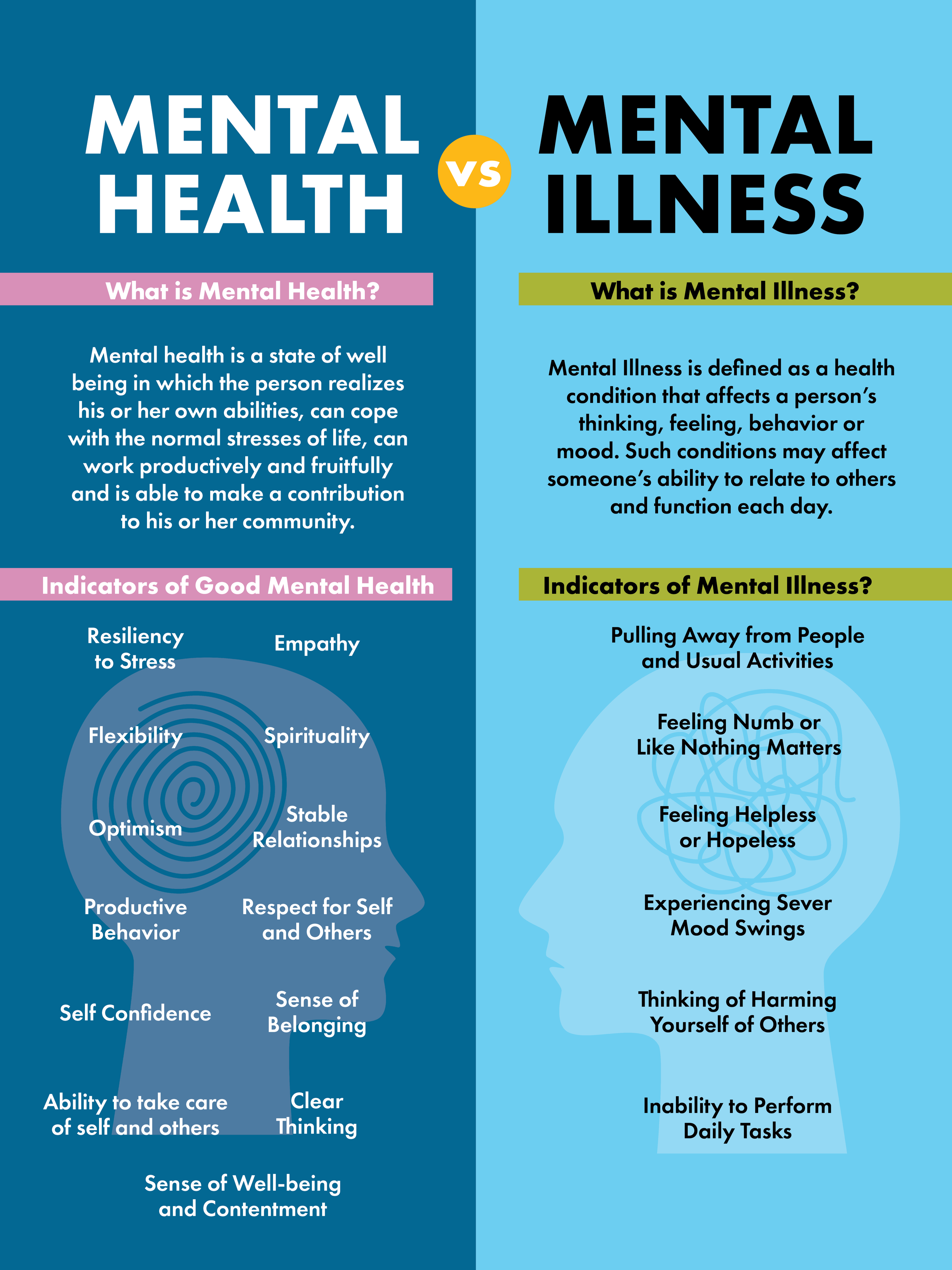Mental Health and Mental Illness Defined
What is Mental Health?
When we refer to mental health, we’re talking about psychological, emotional, and social well-being. Throughout our lives, our mental health plays a role in the way we think, feel, and act. It influences how we handle life, relate to others, and make choices.
Mental health is an integral part of our overall health. It gives us the capacity to:
Think rationally and logically
Cope with life changes, loss, stress, and trauma
Accept limitations and boundaries
Realize our full potential
Work productively
Make meaningful contributions to our communities
A mentally healthy person can choose among thoughts, shift flexibly between them, and match mood and emotional expression to the present situation.
What is Mental Illness?
A mental illness is a disease that causes mild to severe disruptions in the way a person thinks, feels, and behaves.
Like other organs of the body, the brain is vulnerable to disease and disorders. And, like other diseases, such as diabetes or asthma, mental illnesses can have physical and psychological symptoms.
The good news is that with the right care and treatment, people with mental disorders can manage their illness, get better, and return to normal activities.
There are more than 200 types of psychiatric illnesses listed in The Diagnostic and Statistical Manual of Mental Disorders, Fifth Edition (DSM-5-TR). Published by the American Psychiatric Association, the DSM-5-TR is used by mental health practitioners in the United States for diagnosing mental disorders.
Mental illnesses include major depressive disorders, schizophrenia, bipolar disorders, obsessive-compulsive disorder (OCD), panic disorder, post-traumatic stress disorder (PTSD), addictions, and borderline personality disorder.
Most mental illnesses are experienced on a spectrum of severity: At one end are well-adjusted, successful individuals whose disorders are invisible to others. At the other end of the spectrum are those who are too severely impaired to lead normal lives. Serious mental health disorders can interfere with daily life and limit their ability to realize their full potential.
Causes of mental disorders
Although doctors and researchers continue to learn new things about the brain, many of its functions are still not completely understood. The underlying causes of mental illnesses are biopsychosocial – that is, partly biological (your physical body), partly psychological (your emotions and experiences), and partly social (your environment).
These components span:
Biological issues, such as genes, physical illness, injury, or brain chemistry
Developmental experiences, including adverse childhood experiences, trauma or abuse
Social issues, such as poverty, unemployment, job stress, or loss through death or divorce
Research points to mental health problems as a reaction to excessive stresses, genetic factors, biochemical imbalances, or the interplay of all three. They are not caused by character flaws, laziness, or personal weakness. Some people need professional help, such as treatment with therapy and/or medication, to get better.
What are common symptoms of mental illnesses?
Common symptoms include:
Excessive anxiety
A depressed mood or a mood that fluctuates excessively
Disturbing thoughts
Behaviors that are harmful or disturbing to oneself or to others
Memory problems
Changes in sleep patterns
Seeing or hearing things that are not perceived by others
Changes in personality, personal habits and/or social withdrawal
Extreme sadness
Irritability
More than 50 percent of Americans will meet the criteria for a mental disorder at some point in their lifetime. Some of these disorders will be mild and not interfere with social or occupational functioning, nor necessarily cause personal distress. For example, someone with a specific phobia, such as a fear of dogs or of riding in elevators, may be able to manage life without difficulty.
However, most disorders will cause distress, and/or occupational or social dysfunction. About 18 percent of Americans have a mental disorder that does cause such distress. Unfortunately, many in this category do not seek help for their condition.
When should a person seek help?
As with most medical problems, early treatment leads to better outcomes. Sometimes people don’t seek treatment because they don't know what treatment options are available; they may feel embarrassed or ashamed; or they may not know that their thinking or behavior is a problem.
If you or someone you know is experiencing symptoms that may indicate a mental disorder, consider getting a consultation with a mental health professional or your primary care physician.
How common are mental disorders and illnesses?
Mental illness can affect anyone regardless of age, race, religion, origins, or socioeconomic status. In 2021, nearly one in five U.S. adults had experienced some form of mental illness during the past year. And one in 25 Americans lives with a serious mental illness, such as major depression, bipolar disorder, or schizophrenia.
Unfortunately, mental illness often strikes individuals in the prime of their lives, during adolescence or young adulthood. We know that 50 percent of people who develop a psychiatric illness have symptoms of a disorder before age 14, and 75 percent will have symptoms by age 25. All ages are susceptible, but the young and the old are especially vulnerable.
Source: Centers for Disease Control and Prevention, https://www.cdc.gov/mentalhealth/learn/index.htm


